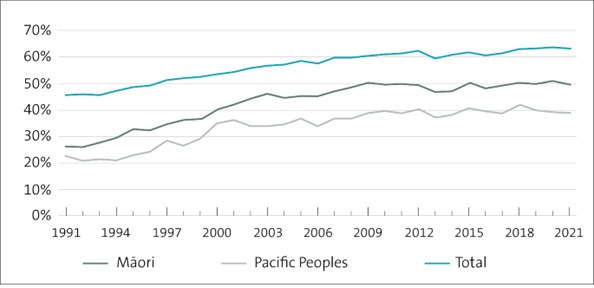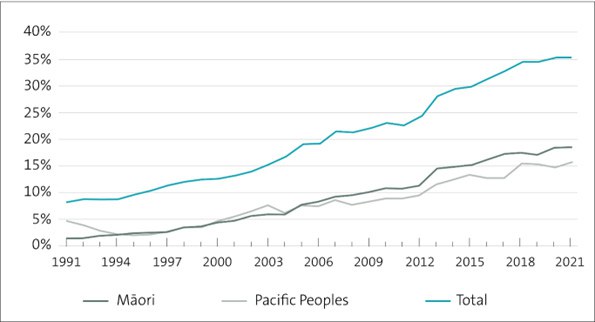Annex 2: Improving student achievement
Every year in New Zealand, a significant number of students fail to complete their tertiary education courses, and many drop out of the system after their first year. We understand that research carried out in 2020 showed that 43% of university students either pre-enrolled for their first year of study but did not attend or did not re-enrol for a second year.
Figure 1 – All learner course completion rates
| All provider based learner completion rates (levels 1-10) | 2022 | 2021 |
|---|---|---|
| Māori | 72.2% | 73.5% |
| Pacific | 68.8% | 71.7% |
| Non-Māori and non-Pacific | 85.3% | 86.4% |
| All work based learner programme completion rates | 2022 | 2021 |
|---|---|---|
| Māori | 59.6% | 61.4% |
| Pacific | 64.1% | 65.7% |
| Non-Māori and non-Pacific | 66.4% | 67.1% |
Source: Tertiary Education Commission annual report 30 June 2023, pages 129 to 135.
As shown in Figure 1, qualification completion rates for Māori and Pacific students are significantly behind non-Māori and non-Pacific. As shown in Figures 2 and 3, these rates have been this way for a long time. Based on the performance information on retention and completion rates reported by the Tertiary Education Commission (the TEC) in its 30 June 2023 annual report, this is particularly the case for Māori and Pacific learners working towards a level 7 qualifications or above (see Figure 2). Level 7 qualifications are those where the student obtains a bachelor’s degree or similar qualification.
Strategies and initiatives
As noted in the Education and Workforce committee’s recent annual review hearings, 312 initiatives have been deployed across the sector to address disparities in student outcomes. They do not appear to have significantly changed student success rates.2
In 2020, the then Government confirmed equity as a priority in its Tertiary Education Strategy (TES). The TES remains the current strategy. Generally, the TES focuses the tertiary education system on being able to give each student the opportunity to get the support and resources they need to achieve their educational goals.
The TES has identified several priorities directly related to equity, including ensuring places of learning are safe, inclusive, and free from discrimination and bullying, as well as reducing barriers to education for all.
Figure 2 – Working age population with a tertiary certificate or diploma or higher

Source: Education attainment of the population, Education Counts website (www.educationcounts.govt.nz).
The TEC is responsible for giving effect to the TES in keeping with the requirements in the Education and Training Act 2020.
Since 2018, the TEC has been developing the Ōritetanga – Learner Success work programme (the programme). The goal of the programme is to improve equity of education outcomes for all learners but especially those who, on average, have lower retention and completion rates than others. The programme requires all parts of the system to support success, including:
- learners and their influencers having the support and experiences to make good educational and career choices;
- communities (including iwi/Māori and Pacific) having an empowered voice in shaping the system; and
- tertiary education leadership being capable, focused, and accountable at all levels.
The programme’s approach to increasing institutional capability has two main components. The first is a framework that is used to identify improvement, and the second is focused on organisational capabilities. The programme uses the approaches developed through Achieving the Dream3 and by Georgia State University (GSU) in the United States. GSU has subsequently reported an increase in overall graduation rates by 23%, and has seen Black, Hispanic, and low-income students graduating at or above the rate of the student body overall for six years running.
Figure 3 – Working age population with a level 7 bachelor’s qualification or higher

Source: Education attainment of the population, Education Counts website (www.educationcounts.govt.nz).
After several years of testing the programme with the sector to validate its effectiveness in New Zealand, the TEC started to roll out the approach in 2022. This began with requiring TEIs to provide a plan for how their institutions would achieve equitable outcomes. The plans needed to outline how these outcomes would be achieved against the framework and organisational capabilities. To support this, the TEC has developed a Learner Success Diagnostic Tool which enables institutions to assess and understand their strengths and weaknesses against the seven organisational capabilities.
The results of this work were to be included in learner success plans (LSPs) by all institutions that receive over $5m in funding. LSPs were expected to be owned and endorsed at the Council/Board level, and outline how and when an institution will achieve equity of outcomes. Institutions also needed to show alignment or use of the framework and their capabilities. Based on the content of the current LSPs, the TEC set an expectation that the largest institutions would achieve equity of education outcomes (qualification completions) by 2031.
At about the same time, the TEC set expectations for institutions that receive over $5m in funding to develop Disability Action Plans (DAPs). A DAP is intended to help an institution identify how it can improve the support that it provides for disabled students. The TEC’s expectation was that each institution would use their DAP to measure and report their progress. To make it easier to develop a DAP, the TEC supported the redevelopment of the Kia Ōrite Toolkit – the New Zealand code of practice to achieve an inclusive and equitable tertiary education environment for disabled learners.
The intention was that LSPs and DAPs would include specific milestones and goals that the institution would put in place to address their specific equity gaps. The TEC was to assess the quality of the plans, monitor their progress on an ongoing basis, and use the results to inform its wider investment decisions. The TEC monitors progress against LSP/DAP milestones in the following ways:
- regular engagements with senior leaders of institutions;
- assessment of educational performance indicators; and
- other information gathered through its standard investment and Crown monitoring functions.
The Accelerating Learner Success (Tūwhitia) Fund (the Fund) was also set up to accelerate the implementation of LSPs. The Fund has set aside $5 million to be spent in 2023/24. The plan was to spend $10 million for each year thereafter. The purpose of the Fund was to provide targeted co-investment in learner success efforts with individual institutions and assist them to overcome cost barriers that otherwise might have delayed progress towards meeting the needs of diverse learners. The TEC is expected to report on funded initiatives, and institutions that access the Fund are required to share the results of their initiatives with the sector. In 2023, in collaboration with the sector, the TEC established a community of practice that allows institutions to share what they are doing and create informal networks around similar areas of focus.
In a related piece of work, earlier in 2022/23 the National Careers System Strategy was updated. This was done to provide clearer guidance about career support and the diversity of those who deliver it, including understanding and removing the barriers preventing people accessing the career support they need.
Sector wide reporting on student achievement
In 2022, the Ministry of Education published Ngā Ara o te Mātauranga – the first “pathways of education” report. The report is published annually and is intended to show the progress made by government agencies towards the 30-year vision for education. The report covers the entire education system, from early learning to tertiary education. There is no specific requirement in legislation about the pathway elements of the report, and the pathway information is not required to be audited.
The second pathways report, published in October 2023, contains information about work to address educational disparities as outlined in the TES. Under the Learner Success Framework heading, it identifies that the Ōritetanga programme will support Priority 2: Have high aspirations for every ākonga, and support these by partnering with their whānau and communities to design and deliver education that responds to their needs, and sustains their identities, languages, and cultures.
It also identifies that the programme will support Priority 3: Reduce barriers to education for all, including for Māori and Pacific ākonga, disabled ākonga and those with learning support needs.
International evidence indicates that it can take five to seven years before improvement in equity can be seen. The programme was rolled out in 2023 and 2024, so it is too early to identify changes in retention or course and qualification completion rates. The TEC has explained that its focus so far has been on organisational commitment and the delivery of LSP milestones, with more work to be done on developing a learner success measurement framework that will track shifts in performance over time. In the meantime, the TEC intends reporting on progress in its upcoming 30 June 2024 annual report. The TEC is also reporting quarterly to the Ministry of Education and the Minister for Tertiary and Skills about how it is achieving against the objectives outlined in its Statement of Performance Expectations 2023/24, and its Statement of Intent 2022/23-2025/26.
Several different countries report on progress in different ways. For example, the National Centre for Student Equity in Higher Education in Australia provides access on its website to data about student equity outcomes in Australian higher education. This information can be sorted by different institutions, and comparisons can be made between institutions for different equity groups (such as students with a non-English speaking background or Indigenous students). This information is a useful way to assess changes in student outcomes over time.
Other examples include the infographics the University of Calgary’s Office of Equity, Diversity, and Inclusion publishes on its website, which compare educational achievement in the total Canadian population to different student levels (such as under-graduate students), as well as academic and support staff. This information provides an easy-to-understand snapshot of which groups experience inequity in outcomes.
We will be providing the Committee with lines of inquiry to support its scrutiny of the TEC and the Ministry of Education in the select committee’s annual review process.
2: 2022/23 Annual Reviews of the Education sector, published by the Education and Workforce Committee on 28 March 2024, page 18.
3: Achieving the Dream is an organisation in the United States that works with colleges and other educational institutions to address equity issues.
